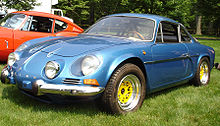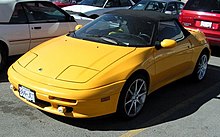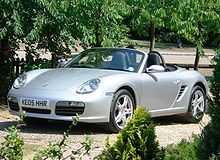| Revision as of 21:06, 11 January 2010 editMuZemike (talk | contribs)Autopatrolled, Extended confirmed users71,096 editsm Reverted edits by 167.86.132.105 to last revision by Ivan Pozdeev (HG)← Previous edit | Revision as of 18:54, 12 January 2010 edit undo65.51.107.202 (talk) →Sports cars versus exotic carsTag: repeating charactersNext edit → | ||
| Line 22: | Line 22: | ||
| One definition that may be used to differentiate between a sports car and an ''exotic car'' is the number of vehicles in existence. A possible rule of thumb is the expectation that fewer than 8,000 cars are produced each year by an exotic car manufacturer, while a mass manufacturer of sports cars may produce model numbers into the tens and hundreds of thousands.<ref name=exotic101></ref> | One definition that may be used to differentiate between a sports car and an ''exotic car'' is the number of vehicles in existence. A possible rule of thumb is the expectation that fewer than 8,000 cars are produced each year by an exotic car manufacturer, while a mass manufacturer of sports cars may produce model numbers into the tens and hundreds of thousands.<ref name=exotic101></ref> | ||
| {{clear}} | {{clear}} | ||
| cars go vroom vroom.!!!!!!! | |||
| smoke fat blunts.! | |||
| ==Sports car versus sporting models== | ==Sports car versus sporting models== | ||
Revision as of 18:54, 12 January 2010
This article is about roadgoing cars. For racing cars, see Sports car racing.| The factual accuracy of part of this article is disputed. The dispute is about The characteristics of the motorized vehicle the article refers to. Please help to ensure that disputed statements are reliably sourced. See the relevant discussion on the talk page. (July 2009) (Learn how and when to remove this message) |

The term sports car has been defined as "an open, low-built, fast motor car." The term describes a class of automobile with two seats, two doors, precise handling, brisk acceleration, and sharp braking — trading practical considerations such as passenger space, comfort, and cargo capacity — for driving enjoyment.
Overview
Sports cars can be either luxurious or spartan, but driving and mechanical performance is requisite. Many drivers regard brand name and the subsequent racing reputation and history as important indications of sporting quality (for example, Porsche, Lotus, or Ferrari), but some exotic car brands, such as Lamborghini, which do not race or build racing cars, are also highly regarded by sports car enthusiasts.
Sports cars versus exotic cars
 An exotic (Pagani Zonda PS)
An exotic (Pagani Zonda PS) Not an exotic (Mazda MX-5 NA 971)Examples of exotic and non-exotic sports cars
Not an exotic (Mazda MX-5 NA 971)Examples of exotic and non-exotic sports cars
One definition that may be used to differentiate between a sports car and an exotic car is the number of vehicles in existence. A possible rule of thumb is the expectation that fewer than 8,000 cars are produced each year by an exotic car manufacturer, while a mass manufacturer of sports cars may produce model numbers into the tens and hundreds of thousands.
cars go vroom vroom.!!!!!!! smoke fat blunts.!
Sports car versus sporting models
A car may be a sporting automobile without being a sports car. Performance modifications of regular, production cars, such as sport compacts, sports sedans, muscle cars, hot hatches and the like, generally are not considered sports cars, yet share traits common to sports cars. They are sometimes called "sports cars" for marketing purposes for increased advertising and promotional purposes. Performance cars of all configurations are grouped as Sports and Grand tourer cars or, occasionally, as performance cars.
What makes a sportscar a Sportscar

A sports car does not require a large, powerful engine, though many do have them. Many classic British sports cars lacked powerful engines, but were known for exceptional handling due to light weight; a well-engineered, balanced chassis; and modern suspension (for example, Lotus Seven, Austin 7 Speedy). On tight, twisting roads, such a sports car may perform more effectively than a heavier, more powerful car.
History

The sports car traces its roots to early 20th century touring cars. These raced in early rallys, such as the Herkomer Cup, Prinz Heinrich Fahrt, and Monte Carlo.
The first true sports cars (though the term would not be coined until after World War One) were the 3 litre 1910 Vauxhall 20 hp (15 kW) and 27/80PS Austro-Daimler (designed by Ferdinand Porsche).
These would shortly be joined by the French DFP (which became sporters after tuning by H.M. and W. O. Bentley, the Rolls-Royce Silver Ghost. In the U.S. (where the type was variously called roadster, speedster, runabout, or raceabout, there was Apperson, Kissel, Marion, Midland, National, Overland, Stoddard-Dayton, and Thomas among small models (which today would be called sports cars), while Chadwick, Mercer, Stutz, and Simplex were among large ones (which might today be called sports sedans or grand tourers).
In 1921, Ballot premiered its 2LS, with a remarkable 75 hp (56 kW) DOHC two liter, designed by Ernest Henry (formerly of Peugeot's Grand Prix program), capable of 150 km/h (90 mph); at most, one hundred were built in four years. This was followed by the SOHC 2LT and 2LTS. The same year, Benz built a supercharged 28/95PS four for the Coppa Florio; Max Sailer won.
Simson in 1924 offered a Paul Henze-designed 60 hp (45 kW) DOHC 2 liter four, the Simson Supra Type S, in a long-wheelbase 120 km/h (60 mph) tourer and 115 km/h (71 mph) twin-carburettor sporter; only thirty were sold, against around three hundred of the SOHC model and 750 of the pushrod-six Type R. Duerkopp's Zoller-blown two liter in 1924, as well.
There was a clear cleavage by 1925. As four-seaters were more profitable, two-seaters increasingly turned over to specialst manufacturers, led by Alvis, Aston-Martin, and Frazer-Nash, with shoestring budgets, fanatic followers, and limited sales (today exemplified by Aston and Morgan): between 1921 and 1939, 350 Astons were built; 323 Frazer-Nashes in the period 1924-39.
By the end of the 1920s, AC produced a 2 liter six, the 3.5 liter Nazzaro had a three-valve OHC (only until 1922), while French makers Amilcar, Bignan, Hispano-Suiza, and Samson had the typical small four-cylinder sporters and Delage, Hotchkiss, and Chenard-Walcker the large tourers. Benz introduced the powerful SS and SSK, and Alfa Romeo, the Vittori Jano-designed 6C.
Two companies would offer the first really reliable sports cars: Austin with the Seven and Morris Garages (MG) with the Midget. The Seven would quickly be "rodded" by numerous companies (as the Type 1 would be a generation later), including Bassett and Dingle (Hammersmith, London); in 1928, a Cozette blower was fitted to the Seven Super Sports, while Cecil Kimber fitted an 847 cc Minor engine, and sold more Midgets in the first year than MG's entire previous production.
Layout



The drive train and engine layout significantly influences the handling characteristics of an automobile, and is crucially important in the design of a sports car.
The front-engine, rear-wheel drive layout (FR) is common to sports cars of any era and has survived longer in sports cars than in mainstream automobiles. Examples include the Caterham 7, Mazda MX-5, and the Chevrolet Corvette.
In search of improved handling and weight distribution, other layouts are sometimes used. The RMR layout is commonly found only in sports cars — the motor is centre-mounted in the chassis (closer to and behind the driver), and powers only the rear wheels. Some high-performance sports car manufacturers, such as Ferrari and Lamborghini prefer this layout. Many modern cars, especially grand tourers, also use a FMR layout, with the motor sitting between the front axle and the firewall.
Porsche is one of the few remaining manufacturers using the rear-engine, rear-wheel drive layout (RR). The motor's distributed weight across the wheels, in a Porsche 911, provides excellent traction, but the significant mass behind the rear wheels makes it more prone to oversteer in some situations. Porsche has continuously refined the design and in recent years added electronic driving aids (i.e. computerised traction-stability control) to counteract these inherent design shortcomings.
Some sport cars have used the front-engine, front-wheel drive layout (FF), e.g. Fiat Barchetta, Saab Sonett and Berkeley cars. This layout is advantageous for small, light, lower power sports cars, as it avoids the extra weight, increased transmission power loss, and packaging problems of a long driveshaft and longitudinal engine of FR vehicles. Yet, its conservative handling effect, particularly understeer, and the fact that many drivers believe rear wheel drive is a more desirable layout for a sports car make this layout atypical to high-performance sports cars. The FF layout, however, is common in sport compacts and hot hatches, and cars in general (excepting sports cars).
Before the 1980s few sports cars used four-wheel drive, which had traditionally added a lot of weight. Although not a sports car, the Audi Quattro proved its worth in rallying. With its improvement in traction, particularly in adverse weather conditions, four-wheel drive is no longer uncommon in high-powered sports cars, e.g. Porsche, Lamborghini, and the Bugatti Veyron.
Seating
Some sports cars have small back seats that are really only suitable for luggage or small children. Such a configuration is often referred to as a 2+2 (two full seats + two "occasional" seats).
Over the years, some manufacturers of sports cars have sought to increase the practicality of their vehicles by increasing the seating room. One method is to place the driver's seat in the center of the car, which allows two full-sized passenger seats on each side and slightly behind the driver. The arrangement was originally considered for the Lamborghini Miura, but abandoned as impractical because of the difficulty for the driver to enter/exit the vehicle. McLaren used the design in their F1.
Another British manufacturer, TVR, took a different approach in their Cerbera model. The interior was designed in such a way that the dashboard on the passenger side swept toward the front of the car, which allowed the passenger to sit farther forward than the driver. This gave the rear seat passenger extra room and made the arrangement suitable for three adult passengers and one child seated behind the driver. The arrangement has been referred to by the company as a 3+1. Some Matra sports cars even had three seats squeezed next to each other.
See also
- List of sports car manufacturers
- Coupe
- Fuel cell sports car
- Grand tourer
- Hot hatch
- Muscle car
- Roadster
- Sport compact
- Sports car racing
- Sports sedan
- Supercar
References
- Shorter Oxford English Dictionary Vol II N-Z (3rd ed.). Oxford University Press. 1968.
{{cite book}}: Cite has empty unknown parameters:|laydate=,|separator=,|trans_title=,|month=,|trans_chapter=,|laysummary=,|chapterurl=, and|lastauthoramp=(help) - Pollard, Elaine; Liebeck, Helen, eds. (1994). The Oxford Paperback Dictionary (4th ed.). Oxford University Press. p. 776. ISBN 0192800124.
{{cite book}}: Cite has empty unknown parameters:|laydate=,|separator=,|trans_title=,|laysummary=,|trans_chapter=,|chapterurl=,|month=, and|lastauthoramp=(help) - Csaba Csere and Tony Swan (2005-01). "10 Best Cars: Best Luxury Sports Car". Car and Driver. Retrieved 2006-10-07.
{{cite web}}: Check date values in:|date=(help) - Examiner.com - Exotic Cars 101: What is an 'Exotic Car' (by definition)?
- Crossa, Robert G. and Dixit, Ashutosh. "Customer-centric pricing: The surprising secret for profitability" Business Horizons, Volume 48, Issue 6, November-December 2005, Pages 483-491.
- ^ Georgano, G. N. (1985). Cars: Early and Vintage, 1886-1930. London: Grange-Universal.
- "Early Handling Problems and Solutions". Retrieved 2008-09-16.
External links
- "Best All-Around Sports Car", Road & Track, March 2005
- "What is a Sports Car?", Jean-Francois Ingenbleek, Universitd Libre de Bruxelles & Jean LeMaire, Wharton School, University of Pennsylvania
- Donovan, Sandra (2007). Sports Cars. Lerner Publications. pp. 48pp. ISBN 08-2255-928-5.